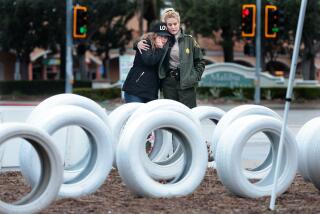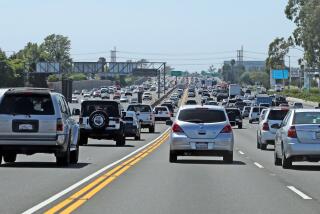It’s Kamikaze Time on the Freeways
- Share via
I amused the salesman when I drove my new red pickup truck back to the sales yard to have a protector finish put on it. My earnest relief was evident.
“Thank goodness I can now keep up, or nearly so, with the killer women and men roaming our freeways,” I remarked.
My 10-year-old pickup, which I traded in for peanuts, had been showing signs of advanced senility. It was wobbly in the joints, as well as in the steering mechanism, and its pick-up and go was worse than mine at the end of a hard day.
Driving our freeways, loaded with kamikaze-type drivers, had become a terrifying experience for me in my old truck. Not that I wished to, nor was I psychologically capable of it, but at least in a new truck I could compete in a limited way on the race track.
And race tracks the freeways have become. The 55-mile-an-hour speed limit is purely academic. I experimented the other day by driving my new vehicle at exactly 55. The experience was almost as terrifying as it was in my wobbly old truck.
I was tailgated mercilessly. I was subjected to cars weaving in and out on both sides of me at dizzying speeds. Nobody, except the halt and lame, it seems, ever goes 55 anymore. Sixty-five, 70, even 80 are the order of the day.
Young women, with today’s popular dark-shaded eyes and frizzy hair, raced by me, squirting in and out between cars, with distances between them hardly enough to drive a motorcycle through, it seemed.
I am puzzled and remain frightened at today’s freeway driving. I long for the comfortable old top speed of 45 m.p.h., and for the old motor vehicle code that did not permit passing on the right and when turning left you eased your way into the traffic flow by turning into the left lane first. Nowadays, a left turn means to many that they must scoot clean across all lanes, a dangerous maneuver.
There’s talk that the speed limit should be raised to 65 because, it’s argued, few travel at 55 anymore. It seems to me a specious argument. In the good old 45 days there were law breakers who went 50 or 60. But the majority obeyed the speed limit. I wish I could say the same for the majority today.
Raising the speed limit would only foster driving faster yet among those whose mentality it is to get somewhere as fast and recklessly as they can. I see by the newspaper that Brian O’Neill, president of the Insurance Institute for Highway Safety, says that 55 does indisputably save lives.
He points out that studies with careful statistical controls for the effects of factors other than speed limit prove that about half of the dramatic reduction in highway fatalities during the mid-1970s was directly attributable to the 55 limit.
“It’s true that many motorists go faster than 55, but that’s not because of the law. Earlier speed limits of 65 and 70 m.p.h. were routinely exceeded, too, so raising the speed limit won’t produce a nation of law-abiders,” he comments.
The emerging Southern California urban shape is decentralized. We are becoming a mega-city called Southern California. Thus comments David D. Grayson, director of engineering and technical services of the Auto Club of Southern California. Grayson is worried about how people will get around in the year 2000--a mere 14 years from now!--when 19 million people will call Southern California their home. That is 3 million more than today.
Our freeway system already is straining to serve the present population. More freeways will have to be built and the older ones expanded, creating a worse traffic mess than now.
Faced with this alarming prospect, somehow the reckless, aggressive--I call it “killer instinct”--attitude toward driving must be modified. I haven’t the slightest idea how, except to beef up state highway patrols and launch a mammoth media campaign for safe, sensible driving.
The campaign might begin with a picture of a smiling, relaxed old guy in a new red pickup truck, saying something about how pleasant it is to motor along at 55 in the company of courteous drivers traveling the same speed and not squirting in and out like a pack of idiots looking for a way to kill somebody or themselves.
More to Read
Sign up for Essential California
The most important California stories and recommendations in your inbox every morning.
You may occasionally receive promotional content from the Los Angeles Times.










